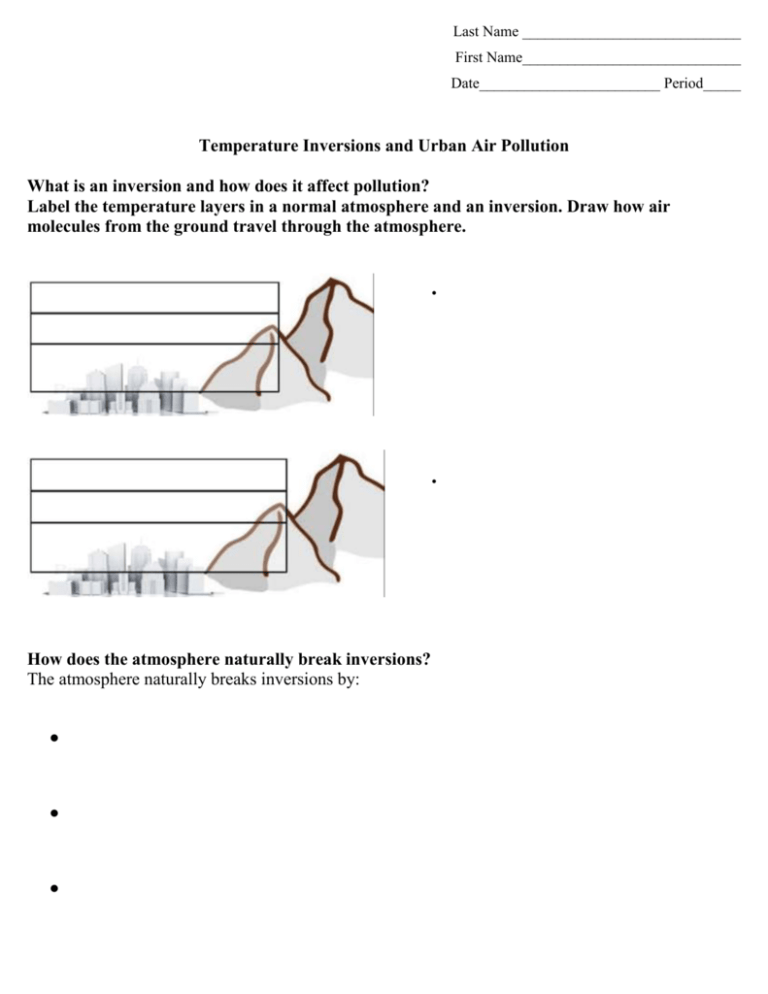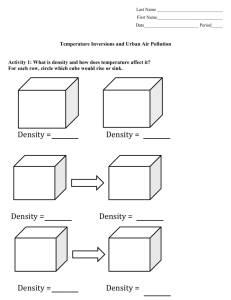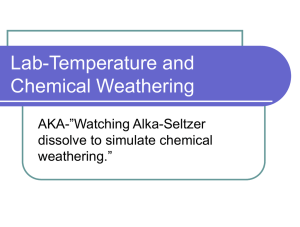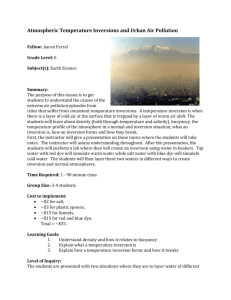Inversion Worksheet
advertisement

Last Name _____________________________ First Name_____________________________ Date________________________ Period_____ Temperature Inversions and Urban Air Pollution What is an inversion and how does it affect pollution? Label the temperature layers in a normal atmosphere and an inversion. Draw how air molecules from the ground travel through the atmosphere. . . How does the atmosphere naturally break inversions? The atmosphere naturally breaks inversions by: Last Name _____________________________ First Name_____________________________ Date________________________ Period_____ Simulating a Temperature Inversion and Urban Air Pollution Question: What will happen when less dense water sits on top of denser water? What happens when denser water sits on top of less dense water? Hypothesis: If denser water sits on top of less dense water, then the water will More Dense ______________________________________________________________________________ Less Dense ______________________________________________________________________________ Hypothesis: If less dense water sits on top of denser water, then the water will ______________________________________________________________________________ ______________________________________________________________________________ Material List: (2) 250 mL beakers (1) 150 mL Water Salt Spoon Funnel Plastic Tubing Red Dye Less Dense More Dense Blue Dye Plastic Dropper Marker Procedure: 1. Label the two 250mL beakers as “Normal” and “Inversion” NORMAL BEAKER INSTRUCTIONS 1. Measure 100 mL of water in “Normal beaker” beaker and stir in one teaspoon of salt until salt is completely dissolved. This simulates cold air. 2. Measure 100 mL of water in the 150mL beaker. Put three drops of red dye in the beaker and stir. This simulates warm air. 3. Carefully insert the tubing into the “Normal” beaker so the tubing touches the bottom of the beaker. 4. Place one end of the beaker over the funnel and tilt slightly until water begins to pour. Pour slowly and carefully, avoiding bubbles. If bubbles arise, pour slower. Remove funnel carefully. INVERSION BEAKER INSTRUCTIONS 1. Measure 100 mL of water “Inversion” beaker. This simulates warm air. 2. Measure 100 mL of water in the 150 mL beaker and stir in one teaspoon of salt until salt is completely dissolved. Put three drops of blue dye with the plastic dropper. This simulates cold air. 3. Carefully insert the tubing into the “Inversion” beaker so the tubing touches the bottom of the beaker. 4. Place one end of the beaker over the funnel and tilt slightly until water begins to pour. Pour slowly and carefully, avoiding bubbles. If bubbles arise, pour slower. 5. After all water is poured, record observations. Normal Beaker I see… Inversion Beaker I see… 6. Put red dye in a plastic dropper. Put the opening of the dropper at the water surface of the beaker labeled “Inversion” and insert three drops. 7. Record observations. Normal Beaker Inversion Beaker Draw a picture of your Normal I see… I see… Beaker Explain your observations… Explain your observations… Draw a picture of your Inversion Beaker Questions: 1. Draw and color a picture of your inversion beaker and label the hot and cold air. 2. How does an inversion make pollution worse? 3. Among your group, discuss ways to reduce pollution. After discussing, write down the top three answers.







